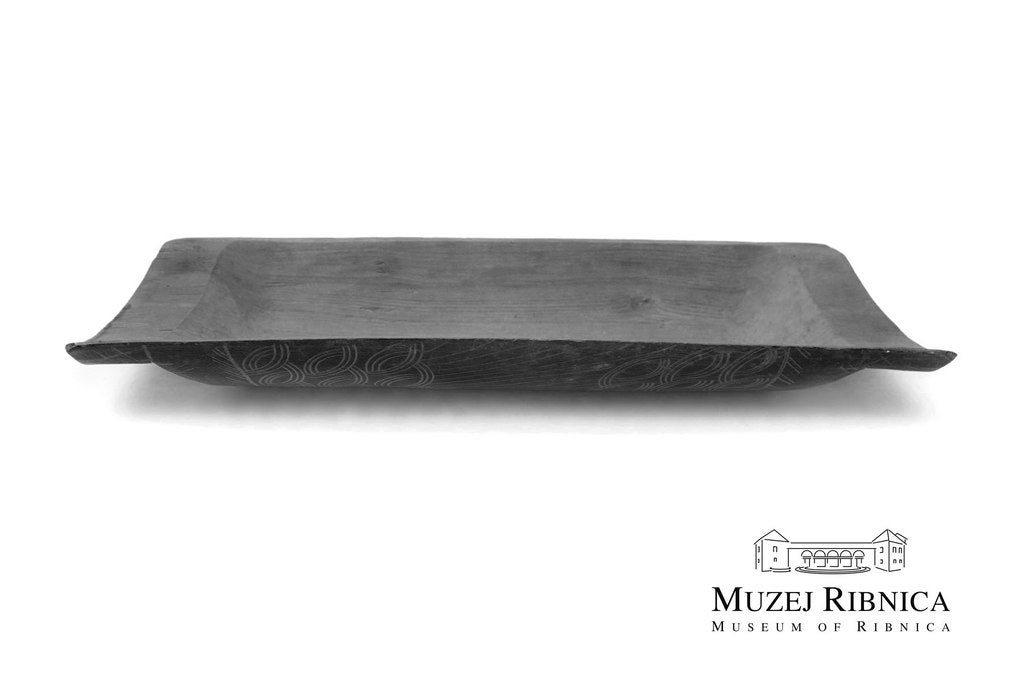NEČKE
NEČKE OR KADUNJE, KNOWN AS "MAUTERLE" IN THE KOČEVJE REGION, WERE UTILIZED IN DIVERSE MANNERS. PARTICULARLY LARGE ONES WERE EMPLOYED FOR BAKING OR DOUGH PREPARATION, WHILE SMALLER ONES WERE HANDY FOR GRAIN CLEANING, KNEADING SMALL BATCHES OF DOUGH, CARRYING LOADS, AND MORE. IN KOČEVJE, IT WAS CUSTOMARY TO PLACE A NEWBORN BABY IN THE ALLI IF THE FIRST CHILD WAS STILL IN THE CRADLE.

Nečke or kadunje, known as "Mauterle" in the Kočevje region, are shallow elongated containers with thin walls, rectangular in shape, made from a single piece of wood. In Kočevje (as well as elsewhere in Slovenia), they were used in various ways. Particularly large ones were used for baking or dough preparation, while smaller ones – about 70 to 80 cm long – were used for cleaning grain, kneading smaller amounts of dough, carrying loads, and more. In Kočevje, if the first child was still in the cradle, they would also place a newborn baby in the nečke. The Kočevje inhabitants were skilled in making nečke. They typically carved them from beech trunks or planks. They would char them over a flame and scrape off the charred layer to prevent the wood from cracking. The depth of large nečke, longer than 150 cm and up to 70 cm wide, was achieved by burning with glowing coals. The outer surface of nečke was often adorned with various geometric ornaments: circular decorations, stars, diamond patterns, straight lines, "s"-shaped lines, plant motifs, hearts, etc., which were either scratched with a knife or carved with chisels and carpentry tools. In the center or on the sides of children's nečke, they typically added a cross symbol or the initials IHS, and just below the rim, they added four wooden pegs for tying a ribbon. Children would sleep in these nečke, they would be carried to baptism, to the doctor, or they would be bathed in them.

The Kočevar krošnjarji, or basket makers, sold nečke throughout the Dolenjska region and other provinces. As noted by Dr. Marija Makarovič, they offered them with the words: "Buy, buy, colorful kadun." The crafting of nečke falls under the category of spoon-making and cooking utensils, a branch of domestic woodworking crafts. The production of dry goods was particularly widespread in the villages around Rož, south of the town of Kočevje.
At the beginning of the 20th century, 207 out of 1241 households in the Kočevje district were still engaged in the production of wooden goods, particularly in villages such as Stari Log, Šemberk, Novi Log, Topli Vrh, Zgornji and Spodnji Komolc, Kunce, Rdeči Kamen, Podstenice, Muha vas, Mokra Gorica, Štale, Ribnik, Zgornja Srednja vas, Topla Gorica, Dolgi Dol, Stene, Rajhenav, Koprivnik, Golobinjek, Gorica, Resje, Mozelj, Rajndol, Verderb, Verdreng, Spodnji Log, and Ravne.
Although the decline due to the large emigration to America and the abandonment of trading in wooden products among the Kočevar krošnjarji was noticeable earlier, the production of dry goods in Kočevje finally ceased after the majority of the population emigrated in 1941/42. It was different in Ribnica, where the tradition of making wooden products has persisted to this day. Years ago, nečke, primarily as souvenirs or containers, were reintroduced by the artisan Matija Kobola from Šalka vas.
